FAQs
Our designers work closely with you during the design phase to create a clear specification of your project. Then our professional craftsman do all of your frame construction right in the store.
While we normally do the entire framing project, we can also do only as much as you want us to do. If you only need a piece of glass or a mat cut, we can accommodate that as well. We will do as much or as little as you would like us to do.
Frame design encompasses much more than simply putting a frame around your picture. A properly completed custom frame establishes protection and creates a presentation for you to enjoy. Whether you are framing a poster, a piece of fine art, your child’s ‘masterpiece’, family photographs, or a hard earned certificate, custom framing will reflect your personal taste and will protect your piece for years to come.
We can frame virtually anything you wish to showcase
Dry mounting is a process which flattens and permanently mounts artwork to the backing board. The ‘dry’ part of the term means that no risky wet adhesives are used in the mounting process. Instead, a sheet of dry adhesive material is placed between the artwork and the backing board. Then both are placed into a large vacuum press which flattens the artwork as it heats the adhesive to cause a permanent bond to the backing board. Our heat/vacuum dry mount presses can mount artwork as large as 40″ x 60″.
Dry mounting serves two purposes:
- One is to flatten the artwork. Paper artwork can easily become wrinkled from handling. Dry mounting will remove virtually all wrinkling from damaged artwork. Even sharp crinkles which have broken the fibers of the paper artwork will be flattened out (although you may still see a line where the fibers were permanently damaged.)
- Second is to keep the artwork flattened, regardless of the environment. Un-mounted artwork will expand and contract over time, depending on heat and humidity. These expansions and contractions can translate into undesirable undulations and bowing of the artwork within the frame. A dry mounted piece of artwork will remain flat, regardless of changes in the surrounding environment.
We take great pride in the craftsmanship and detail that goes into every frame we build. We are dedicated to providing the best service and craftsmanship you can find. Come see us and let us show you what framing craftsmanship and originality can bring to your artwork.
You should not dry mount any artwork which would be reduced in value by being permanently attached to the backing board. This would include original artwork, limited editions and any collectable piece. In the minds of collectors, mounted artwork is not as valuable as the same artwork in its original form.
You should not dry mount art which will melt at 190° F. This would include wax-based artwork, fax paper and some of today’s color copies. In these cases, a careful wet mounting process should be employed in a cold press.
A mat is the thick paper-like material you often see surrounding the artwork, filling in the space between the artwork and the frame.
There are several reasons mats are used in framing.
- First, it is a decorative element that provides a visual space between the art and the frame. This can be especially helpful when you have a carved frame that might look too busy if it were placed immediately next to the art. A mat also helps to keep the finished piece from feeling crowded.
- Second, the mat creates air space between the art and glass, and keeps the glass from touching the artwork In most cases you don’t ever want glass directly against your art because it can condense moisture and damage your art. If the glass is in contact with the image, there is a risk of mold and/or adhesion between the two substances where they touch. The mat is normally positioned on top of the artwork, and the glass (glazing) is positioned on top of the mat. The thickness of the mat then determines just how far away from the artwork the glass is held, leaving a protective air space between the two.
- Third, matting can be used to make a piece of artwork fit into a pre-made frame which is too large. A mat is cut with outside measurements to match the frame size and inside measurements to match the image size, thus filling in the empty space between the artwork and the perimeter of the pre-made frame. You may want to use mats to make your finished frame bigger so that it will cover a larger wall area than the framed image would by itself.
Conservation framing (also known as preservation framing) is the professional application of knowledge, materials and techniques to the framing of valuable artwork such that the artwork is not permanently altered in any way. In short, it is doing everything possible to ensure that a piece of artwork removed from the frame at a later date will not show any evidence of having been framed, thus preserving its long-term value.
However, complete conservation treatment of a particular piece of art is not always appropriate, desired or affordable. Therefore, there are always degrees of appropriate conservation to be applied in any situation. For example, a wrinkled and torn old poster, primarily of sentimental value, might best be dry mounted for its best appearance, but acid free mats and U.V. protective glazing applied to reduce the likelihood of continued deterioration. The designer will advise you of the options and possible consequences, but the degree of conservation is always your choice.
Mounting is a method by which your artwork may be held in place within the frame. In general, there are two categories of mounting:
- Permanent mounting
- Conservation mounting
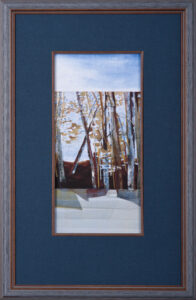
There are advantages and disadvantages to each method, and specific circumstances under which certain methods are recommended.
Permanent Mounting is just that — the irreversible mounting of your artwork onto another material. Permanent mounting is usually done to improve the appearance of your artwork by permanently holding it flat and in position regardless of heat, humidity or physical mistreatment. While the appearance of your artwork may be improved, permanent mounting is not recommended since the value (or potential value) of the artwork may be jeopardized by permanent alteration.
Conservation Mounting encompasses a body of techniques employed to hold your artwork in place without subjecting it to irreversible mounting processes. The objective of conservation mounting is to make it possible to remove your artwork from the frame at a later date without evidence of it having been framed.
Wet mounting is different from dry mounting only by the type of adhesive used to attach the artwork to its backing board. A spray glue or paste is applied between the artwork and the backing rather than using a sheet of dry adhesive. The wet mounted piece is usually processed through the same vacuum press as if it were being dry mounted, except without heat being applied.
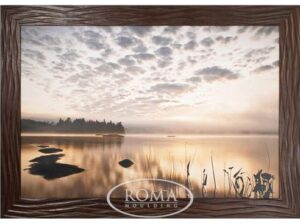
The disadvantages of wet mounting are:
- Moisture is being introduced directly onto the artwork.
- The artwork is usually in more handling jeopardy during the mounting process than if it were being dry mounted. However, some types of artwork cannot withstand the heat of the dry mount process and can only be wet mounted if permanent, full-surface adhesion is desired. Our skilled craftsmen regularly do wet mounting as well as dry mounting, and you will be advised as to which technique is most appropriate for your artwork.
Common, mass-produced picture frames come in a limited number of pre-built sizes — usually 4″x6″, 5″x7″, 8″x10″, 11″x14″ and 16″x20″. Anything larger, smaller or between these sizes is usually found only by exception in the pre-made market.
At Tuxedo Frame Gallery, we custom build your picture frame by hand to exactly the size that is most appropriate to your particular artwork — down to the 16th of an inch. In most cases, your artwork should determine the size of the frame, rather than the other way around as is the case with pre-built frames.
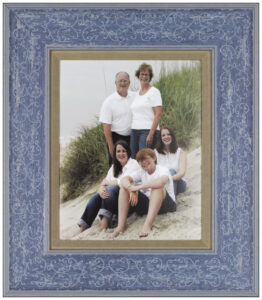
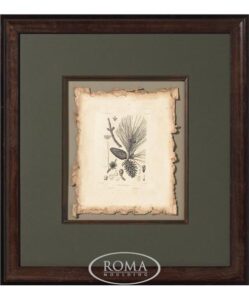
A frame serves three purposes:
- To provide a solid, protective environment in which your artwork will remain safe from physical damage.
- To provide a dependable, non-destructive means of displaying your artwork.
- To provide aesthetic enhancement to the artwork.
If the piece is important to you, you should consider having it professionally framed.
Framing a piece of artwork which is valuable to you, either monetarily or sentimentally,
will make it look better and last longer. And it helps complete a room.
Sometimes it just comes down to which particular frame you think looks best on your artwork, regardless of what it is made. However, there are some basic differences between frame material:
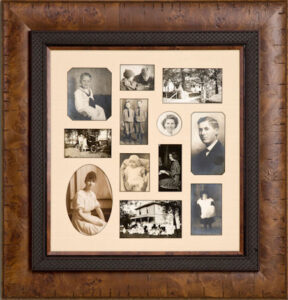
- Wood Moulding Today, wood is still the preferred choice for frame material. It has the widest selection of styles and colors, and often costs no more than metal. Conservationally, wood is superior because it offers a smooth surface back on which to attach the frame’s dust cover which protects the artwork from dust and insects. (Incidentally, manufacturers of wood frames today harvest and replenish their resources with strict regard to the environment.)
- Metal Moulding Metal frames are a modern, durable alternative to wood frames. No longer limited to chrome, today’s metals come in a wide variety of styles and colors. They will withstand a lot of abuse, and should definitely be considered in frame-unfriendly environments. In terms of conservation, metals are not as desirable as woods because an effective dust cover is not applicable to the back of the frame.
At Tuxedo Frame Gallery you will find knowledgeable design personnel on staff. Our designers have extensive framing knowledge and are trained to assist you with all your framing needs. With over 1,000 frame styles, hundreds of mat colors and a dozen types of glazing, they will help you sift through the different options and combinations to make your artwork look its best.
Working on a budget? No problem. Our designers can show you alternatives and advise you on how you might best leverage your dollars. With our computerized pricing system it is easy to try different frames, different mats and different glazing until you find the combination that satisfies your senses and meets your budget.
With over 60 years of combined framing experience, out staff is here to answer your questions and help you design your frames, whether you are designing a wall of family photographs or framing your child’s masterpiece. We are dedicated to providing the best service and craftsmanship you can find.
Floating a piece means to place the piece of art on top of a solid board without cutting a window (opening) for it. This is a great effect if your piece has a deckled or torn edge that you want to show off or if important bits of the image are right at the edge of the paper. Art framed this way often includes spacers or shadowboxing to create air space between the art and glass. We can also raise the art off the backing to create a little extra shadow. This is called a pedestal.
A glass float (or glass sandwich) frame is when two pieces of glass are cut larger than the art and the glass is used like a mat. Keep in mind that the color of your wall will directly affect the way the art looks.
The decision to use matting is, for the most part, a personal, aesthetic choice. Following are some considerations when deciding whether or not to use matting on any particular piece of artwork.
- To avoid damage to your artwork caused by mold and/or adhesion between the artwork and glass, a mat is the best way to hold the glass off of the artwork.
- Cut multiple openings from a single mat to display several images within one frame.
- Mats can form an area around the image upon which decoration can be added, such as French lines, decorative grooves, hand-carved images, signatures, drawings, plaques, etc.
A more recent development is the use of colored matting material. Mat colors can be used to enhance the image or highlight aspects within the image. Additionally, textured fabric, suede, leather and foil can be chosen to enliven the artwork, focus the viewer’s eye, or make a statement of importance or elegance.
That depends on the size of the frame relative to the size of the art. There are two basic approaches to mat widths. One is to make the mat an equal width all the way around the picture – for example, 3″ of matting material on the top, bottom and sides of the image. The second approach (referred to as ‘weighting the bottom’) makes the bottom of the mat wider below the image — for example, 3″ of matting material on the top and sides, but 5″ at the bottom of the image.
In most cases the mat and the frame should not be the same width. In a finished piece this can cause a striping effect that draws the eye away from the picture. Also, it is often the case that a narrow frame will look better with a wide mat and a wide frame will look better with a narrow mat. But none of this is set in stone and each piece presents different considerations and different possible solutions. The preference is yours.
The use of two mats is most common — a wide outer mat, plus a narrow amount of inner mat exposed from under the outer mat. The color of the outer mat is often selected to expand the feeling of the image being framed. The color of the inner mat is often chosen to accent the focal point of the image.
Sometimes no mat at all is most appropriate. Sometimes six mats might be most appropriate. Whatever is most effective for any particular image is the determining factor. Keep in mind that the effect of matting should always be to enhance the artwork, and not overwhelm it.
If your artwork is on paper, then yes, you need glass or plexi to keep bugs and other damaging elements away from it. Art on canvas or wood is usually framed with nothing over it.
Glass is familiar, cheaper and can be cleaned with almost anything. It also has a slight olive tint and if it breaks you usually end up with damaged art. Plexiglass has almost no color tint, is lighter, has about 85% U.V. protection and is very difficult to break. It needs to be cleaned with a soft cloth and non-ammonia cleaner and should not be used on pastel or charcoal drawings without significant spacing. Both glass and plexi are available with 98% U.V. protection. This version of both adds a slight yellowish tint.
The general term for the clear coating, which protects the artwork while allowing you see it, is glazing. There are many forms of glazing, including glass, acrylic, lamination and styrene. And there are many forms within each of these glazing categories, such as clear, non-glare, reduced reflection and U.V. protective. There is no single glazing material that is perfect for all framing conditions. And there are advantages and disadvantages to using each.
- Regular clear glass is the most common type of glazing. It is durable and more scratch-resistant than non-glass forms of glazing material. Common disadvantages are that most forms are brittle and breakable, and weigh more than acrylic glazing alternatives. Regular glass inherently provides a low level of U.V. filtering (less than 50%.)
- Ultraviolet protection is an attribute added to glazing. U.V. protection is available in most forms of clear and non-glare glass or acrylic. Also known as conservation glazing, it is a special coating which filters out more than 97% of the harmful ultra-violet radiation. Conservation glass will significantly reduce the fading damage your artwork experiences as a consequence of being exposed to virtually any source of light. The added benefit outweighs the nominal extra cost.
- Museum glass is the ultimate protection you can give your artwork. It virtually feels as though there is no glass in the frame and provides 99% U.V. protection.
- Acrylic Glazing is second most common type of glazing (to glass), and is often referred to as Plexiglass (which is actually only one brand of acrylic.) It is available in several forms. The major advantages of acrylic are that it weighs significantly less than glass, it resists breaking, and inherently has a higher level of U.V. protection than regular glass (more than 60% filtering.) The only negative is that it is more susceptible to scratching. The acrylic used by Tuxedo Frame Gallery is a picture framing grade. Acrylic glazing is available in Clear and Non-glare forms, and with or without an additional level of U.V. protection.
The sealing of the back of your frame is primarily functional, not decorative. The purpose of sealing the back of the frame is to seal out insects, dust and dirt. All three of these elements love to get inside of a frame without an appropriate backing.
There are four main types of backing applications, the choice being that of the individual framer, unless otherwise specified:
- Paper backing: This is an American style of backing. Adhesive is applied around the perimeter of the back of the frame, a brown or black craft paper is applied and then trimmed. In the USA, this is the style which is most common.
- Framing tape backing: This is a European style of backing. Brown, black or white framing tape is applied around the perimeter of the back of the frame to seal the gap between the frame and the backing board. This can be more durable than the paper backing technique. In Europe, this is style which is most common.
- Oil paintings on canvas: Oils are a special consideration. They are normally paper-backed, but a cut is made in the middle of the backing. The paper backing provides physical protection, plus a degree of protection against dust and dirt. The cut out in the back is necessary to allow the oil to ‘breathe’. An oil never completely dries, and if a cut is not provided through the backing for ventilation, mold may develop on the canvas.
- Metal frames: Metal frames are not backed because they are, for all practical purposes, not sealable due to the convoluted channels inherent to metal frames.
It is important to hang frames securely, using appropriate supplies and techniques. There are different methods you can use depending on the application. Read on for specific examples.
To Hold Heavy Mirrors
Avoid the use of picture wire. Hang directly from strap hangers (a loop over a flat plate that screws into the frame). Rather than traditional wall hooks, use wall anchors such as Molly Bolts, that go through the sheet rock and lock into it.
To Prevent Theft
Security Hangers are available that firmly hold all sides of the frame in place on the wall. A special key tool is needed to lock it and again to unlock it. These are generally used in public places but are also good where the frame may easily be bumped.
To Protect Kids
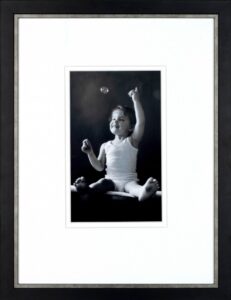
In a kid’s room where things are thrown around, use Security Hangers. If you don’t have access to them, try strap hangers on each side of the frame and heavy duty hooks in the wall for the hanger to sit into. Do not rely on just nails in the wall as they can fall out of the wall or the frame can jump off the nail if something is thrown at it.
To Avoid Crooked Frames on the Wall
When frames are hung from a single point, they usually shift on the wall over time. Both for safety and also to keep frames straight, always hang everything from two points. On heavier pieces this also helps distribute the weight.
To Keep Frames Flush to the Wall
Screw eyes that are often used to attach wire to the frame tend to make the frames lean out from the wall more than they need to. Also, excess slack in the wire can cause the top to lean out. By switching to strap hangers, you can overcome both problems. These hangers are flatter and give you the option of hanging directly from the hanger versus using wire.


